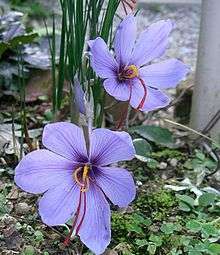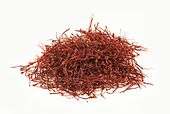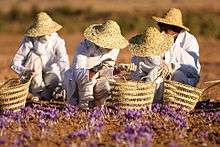Crocus sativus
| Saffron crocus | |
|---|---|
 | |
| Crocus sativus blossom with crimson stigmas | |
| Scientific classification | |
| Kingdom: | Plantae |
| Clade: | Angiosperms |
| Clade: | Monocots |
| Order: | Asparagales |
| Family: | Iridaceae |
| Genus: | Crocus |
| Species: | C. sativus |
| Binomial name | |
| Crocus sativus | |
| Synonyms[1] | |
| |
Crocus sativus, commonly known as saffron crocus, or autumn crocus,[2] is a species of flowering plant of the Crocus genus in the Iridaceae family. It is best known for producing the spice saffron from the filaments that grow inside the flower. The term "autumn crocus" is also mistakenly used for flowers in the Colchicum species. However, crocuses have 3 stamens and 3 styles, while colchicum have 6 stamens and 1 style and are toxic.[3]
This cormous autumn-flowering perennial plant species is unknown in the wild.[2] Human cultivation of saffron crocus and use of saffron have taken place for more than 3,500 years and spans different cultures, continents, and civilizations, see history of saffron. Crocus sativus is currently known to grow in the Mediterranean, East Asia, and Irano-Turanian Region.[4] Saffron may be the triploid form of a species found in Eastern Greece, Crocus cartwrightianus; it probably appeared first in Crete. An origin in Western or Central Asia, although often suspected, is not supported by botanical research.[5] Other sources suggest some genetic input from Crocus pallasii.[6]
Morphology
Crocus sativus has a corm, which holds leaves, bracts, bracteole, and the flowering stalk.[4] These are protected by the corm underground. C. sativus generally blooms with purple flowers in the autumn. The plant grows about 10 to 30 cm high.[7] C. sativus is a triploid with 24 chromosomes, which means it has three times the haploid number of chromosomes. This makes the plant sterile due to its inability to pair chromosomes during meiosis.[8]

Cultivation
Crocus sativus is unknown in the wild, and its ancestor is unknown. The species Crocus cartwrightianus is the most probable ancestor,[9][6] but C. thomassi and C. pallasii are still being considered as potential predecessors.[10] Manual vegetative multiplication is necessary to produce offspring for this species as the plant itself is a triploid that is self-incompatible and male sterile, therefore rendering it incapable of sexual reproduction. This inability to reproduce on its own supports the hypothesis that C. sativus is a mutant descending from C. carthwrightianus as a result of selective breeding.
Corms of Crocus sativus should be planted 4 inches apart and in a trough 4 inches deep. The flower grows best in areas of full sun in well-drained soil with moderate levels of organic content.[11] The corms will multiply after each year, and will last 3–5 years.[12]
Use
Saffron is considered to be the most valuable spice by weight.[4] See spice. Depending on the size of harvested stigmas, 50,000–75,000 Crocus sativus plants are needed to produce about 1 pound of saffron;[13] each flower only produces three stigmas. Stigmas should be harvested mid-morning when the flowers are fully opened.[12] The saffron crocus (Crocus sativus) should not be confused with "meadow" saffron or autumn crocus (Colchicum autumnale) which is poisonous.[14]
Gallery
 Illustration from Köhler's Medizinal-Pflanzen (1897)
Illustration from Köhler's Medizinal-Pflanzen (1897) Flower's profile, Serra de Casteltallat, Catalonia, Spain
Flower's profile, Serra de Casteltallat, Catalonia, Spain

See also
Topics related to saffron:
References
- ↑ "The Plant List: A Working List of All Plant Species". Retrieved 23 April 2015.
- 1 2 "Crocus sativus". Germplasm Resources Information Network (GRIN). Agricultural Research Service (ARS), United States Department of Agriculture (USDA). Retrieved 23 April 2015.
- ↑ A Handbook of Crocus and Colchicum for Gardeners, Bowles, E. A., D. Van Nostrand Company, Inc., 1952, page 154
- 1 2 3 Kafi, M.; Koocheki, A.; Rashed, M. H.; Nassiri, M., eds. (2006). Saffron (Crocus sativus) Production and Processing (1st ed.). Science Publishers. ISBN 978-1-57808-427-2.
- ↑ Mathew, B. (1977). "Crocus sativus and its allies (Iridaceae)". Plant Systematics and Evolution. 128 (1–2): 89–103. doi:10.1007/BF00985174. JSTOR 23642209.
- 1 2 Harpke, Dörte; Meng, Shuchun; Rutten, Twan; Kerndorff, Helmut; Blattner, Frank R. (2013). "Phylogeny of Crocus (Iridaceae) based on one chloroplast and two nuclear loci: Ancient hybridization and chromosome number evolution". Molecular Phylogenetics and Evolution. 66 (3): 617–627. doi:10.1016/j.ympev.2012.10.007.
- ↑ Mollazadeh, Hamid "Razi's Al-Hawi and saffron (Crocus sativus): a review". Iranian Journal of Basic Medical Sciences, Dec 2015.
- ↑ Saxena, R. (2010), "Botany, taxonomy and cytology of Crocus sativus series", AYU, 31 (3): 374, doi:10.4103/0974-8520.77153, PMC 3221075, PMID 22131743
- ↑ Rubio-Moraga, A; Castillo-Lopez, R; Gomez-Gomez, L; Ahrazem, O (23 September 2009). "Saffron is a Monomorphic Species as Revealed by RAPD, ISSR and Microsatellite Analyses". BMC Research Notes. 2 (189). doi:10.1186/1756-0500-2-189. PMC 2758891. PMID 19772674.
- ↑ Grilli Caiola, M. (2003). "Saffron Reproductive Biology". Acta Horticulturae. ISHS. 650: 25–37. doi:10.17660/ActaHortic.2004.650.1.
- ↑ "Growing and Harvesting Saffron Crocus". White Flower Farm.
- 1 2 "Saffron Farming Information Guide". AgriFarming.
- ↑ Hill, T (2004). The Contemporary Encyclopedia of Herbs and Spices: Seasonings for the Global Kitchen (1st ed.). Wiley. p. 273. ISBN 978-0-471-21423-6.
- ↑ https://www.rhs.org.uk/Plants/4190/Colchicum-autumnale/Details
External links

